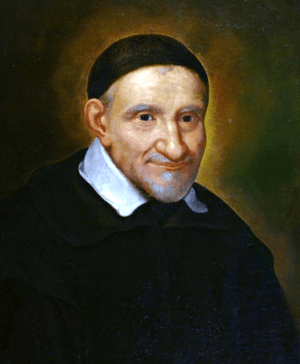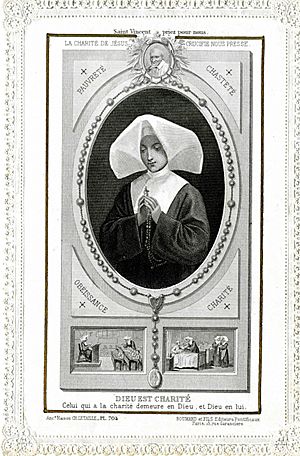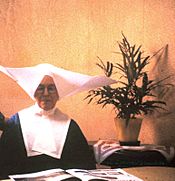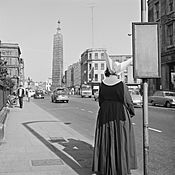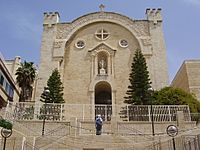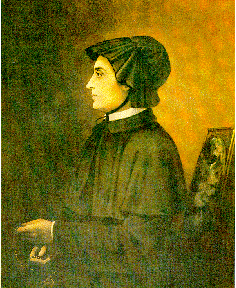Daughters of Charity of Saint Vincent de Paul facts for kids
 |
|

Saint Louise de Marillac, Co-founder of the Company of the Daughters of Charity of Saint Vincent de Paul
|
|
| Abbreviation | D.C. |
|---|---|
| Established | 29 November 1633 |
| Founders |
|
| Founded at | Paris, France |
| Type | Centralized Religious Institute of Consecrated Life of Pontifical Right (for Women) |
| Headquarters | Motherhouse Rue du Bac, Paris, France |
|
Region served
|
Europe, Asia, Americas, Africa |
|
Members
|
14,000 |
|
motto
|
The charity of Christ urges us |
|
Superioress General
|
Sister Françoise Petit, DC |
|
Parent organization
|
Roman Catholic Church |
The Daughters of Charity of Saint Vincent de Paul (often called the Daughters of Charity or Sisters of Charity) is a group of Catholic women. They dedicate their lives to helping people in need. They do this through acts of kindness and service.
This group was started in 1633 by Vincent de Paul and Louise de Marillac. Members make promises each year to serve others. They are known for their motto: "The charity of Christ urges us!"
In France, people sometimes called them "the Grey Sisters." This was because of the color of their traditional clothing. Members use the letters DC after their names. The current leader of the Daughters of Charity is Sister Françoise Petit.
Contents
How the Daughters of Charity Started
The Daughters of Charity began with Vincent de Paul, a French priest. He saw a need to help poor people in his parish. He started a group of women to assist those in need. This idea became very popular.
It spread from small towns to Paris. In Paris, wealthy ladies often sent their servants to help the poor. But the work was not always done well. Vincent de Paul found young women from the countryside who wanted to help.
These young women became the first Daughters of Charity. On November 29, 1633, Louise de Marillac began training them. They learned how to care for the sick. Unlike other religious groups at the time, these sisters did not stay hidden away. They lived and worked among the people they served.
The Daughters of Charity quickly started many helpful projects. They opened soup kitchens and community hospitals. They also created schools and homes for children who had lost their parents. They taught young people to read and write. They even worked to make prisons better.
By 1660, when both Louise de Marillac and Vincent de Paul passed away, there were over forty houses of the Daughters of Charity in France. They were caring for sick people in many parishes in Paris.
Challenges During the French Revolution
During the French Revolution, many religious groups faced difficulties. In 1789, there were 426 houses of the Daughters of Charity in France. About 6,000 sisters were serving across Europe. However, in 1792, the sisters were told to leave their main house. The group was officially closed in 1793.
The new government made people take an oath to support the Revolution. Those who refused were seen as against the Revolution. In Angers, two sisters, Marie-Anne Vaillot and Odile Baumgarten, refused the oath. They were publicly executed in early 1794. Pope John Paul II later honored them in 1984.
Sister Marguerite Rutan was another leader who refused the oath. She worked at a hospital in Dax. She was falsely accused of being against the Revolution. On April 9, 1794, she was sentenced to death and executed. She was honored in 2011.
Other sisters, Marie-Madeleine Fontaine, Marie-Françoise Lanel, Thérèse Fantou, and Jeanne Gérard, were also executed in 1794. They were honored in 1920. These sisters showed great courage during a very difficult time.
Worldwide Growth and Service
After the French Revolution, the Daughters of Charity grew rapidly. Throughout the 1800s, they spread to many countries. These included Austria, Australia, Hungary, Ireland, Israel, Portugal, Turkey, Britain, and the Americas. During this time, they expanded their work to care for orphans and people with physical disabilities.
The first house in Ireland opened in 1855. By 1907, they had many houses and sisters in England, Ireland, and Scotland. They ran orphanages, schools, and hospitals. They also had homes for working girls and trained teachers.
In Jerusalem, the Convent of Saint Vincent de Paul was built in 1886. The sisters built shops in front of the building. They used the rent money to help run the convent. This convent is now part of the Mamilla Mall.
The main house of the Daughters of Charity is in Paris, France. The remains of Louise de Marillac and St. Catherine Labouré are kept there. Catherine Labouré was a Daughter of Charity. In 1830, she said the Blessed Virgin Mary appeared to her. Mary asked her to share the devotion to the Miraculous Medal.
The traditional clothing of the Daughters of Charity was very noticeable. It included a large, stiff white head covering called a cornette. This was the common dress for peasant women near Paris when the group started. In 1964, the sisters adopted a simpler, modern blue dress and veil.
Helping Others in the United States
In the United States, St. Elizabeth Ann Seton wanted to start a similar group. Because of wars in Europe, she could not connect with the Daughters of Charity right away. So, on July 31, 1809, she founded the Sisters of Charity of St. Joseph in Maryland.
In 1810, she received the rules of the Daughters of Charity from Paris. She used these rules to guide her community. By the time she passed away in 1821, there were fifty Sisters. In 1850, her community officially joined the Daughters of Charity in Paris. They then adopted the blue clothing and white head covering. This community in Maryland became the first American branch of the Daughters of Charity.
Other groups of Sisters of Charity also started in the U.S. In 1817, Mother Seton sent sisters to New York. They opened a home for children who needed care. Many parents had died from illnesses, and there was no good sanitation system. In 1846, the New York group became a separate order. They kept their original black clothing and cap.
During the American Civil War, the Daughters of Charity helped as nurses. They cared for soldiers in hospitals and prisoner-of-war camps. In the Spanish–American War of 1898, they again provided nursing services. They helped many sick and wounded soldiers.
Current Work and Impact
As of 2019, about 14,000 Daughters of Charity serve in ninety countries. They help with basic needs like food, water, and shelter. They also work in healthcare, education, and assist migrants and refugees.
In July 2011, four of the five U.S. branches of the Daughters of Charity merged. These were from Maryland, New York, Missouri, and Indiana. The new combined branch is called the Province of St. Louise. Its main office is in St. Louis, Missouri. This new province covers 34 states and Quebec, Canada.
The Daughters of Charity have founded many hospitals, orphanages, and schools. These include Saint Joseph College in Maryland and Santa Isabel College Manila in the Philippines. Five hospitals they founded in the USA still operate today. They are part of the St. Vincent's Health Care System.
In Chicago, Marillac St. Vincent Family Services helps families. They offer early childhood education and programs for youth. They also provide services for seniors and help families get food. This group formed from two older centers that started in 1914 and 1915.
In Mayagüez, Puerto Rico, they help run the Asilo De Pobres. In the Philippines, they manage the College of the Immaculate Conception. In the United Kingdom, the Daughters of Charity are based in London. They are a registered charity. They also operate St. Ann's Infant and Maternity Home near Washington, D.C..
Important People in the Daughters of Charity
Many people connected to the Daughters of Charity have been recognized for their holy lives and good deeds.
Saints
- Louise de Marillac (1591–1660): Co-founder of the Daughters of Charity.
- Vincent de Paul (1581–1660): Co-founder of the Daughters of Charity.
- Elizabeth Ann Seton (1774–1821): Founder of the Daughters of Charity in the United States.
- Catherine Labouré (1806–1876): A sister known for her visions of the Blessed Virgin Mary.
Blesseds
- Marie-Anne Vaillot (1736–1794) and Odile Baumgarten (1750–1794): Martyrs during the French Revolution.
- Marguerite Rutan (1736–1794): A sister who was a martyr during the French Revolution.
- Marie-Madelaine Fontaine (1723–1794), Marie-Francoise Lamel (1745–1794), Therese-Madelaine Fantou (1747–1794), and Jeanne Gerard (1752–1794): Sisters who were martyrs during the French Revolution.
- Rosalie Rendu (1786–1856): She helped organize care for the poor in Paris during the Industrial Revolution.
- Marta Anna Wiecka (1874–1904): A nurse who worked in hospitals in Poland and Ukraine.
- Giuseppina Nicoli (1863–1924): A catechist, meaning she taught about the Catholic faith.
- Melchora Adoración Cortés Bueno, Josefa Martínez Pérez and 25 Companions (died 1936 and 1937): Martyrs during the Spanish Civil War.
- Toribia Marticorena Sola and Dorinda Sotelo Rodríguez (died 1936): Martyrs during the Spanish Civil War.
- Lindalva Justo de Oliveira (1953–1993): A sister who was killed while serving others.
Venerables
- Teresa Gabriella Borgarino (1880–1949)
- Justa Domínguez de Vidaurreta Idoy (1875–1958)
- Pia (Anna) Cantalupo (1888–1983)
Servants of God
- Marie-Anne (Eugenie) Pavillon and 9 Companions (died 1870): Martyrs in China.
- Adèle-Louise-Marie de Mandat-Grancey (1837–1915)
- Barbara (Stanisława) Samulowska (1865–1950)
- Maria Olga (Teresa) Tambelli (1884–1964)
- Francisca (Clemência) Benicia Oliveira (1896–1966)
- Marie-Isabelle-Renée (Cecilia) Charrin Deverchére (1890–1973)
Other Notable Members
- Sister Bernadette Armiger: A nursing leader and advocate for mental health.
- Sister Marguerite Bernes: An Algerian nun recognized for helping people during difficult times.
- Sister Mary Flavia Egan: Graduated from Georgetown University long before women were officially admitted.
- Justina Hermina Pacek: A Slovenian nurse, photographer, painter, and illustrator.
See also
 In Spanish: Hijas de la Caridad de San Vicente de Paúl para niños
In Spanish: Hijas de la Caridad de San Vicente de Paúl para niños
- Institute of Consecrated Life
- Religious institute (Catholic)
- Secular institute
- Sisters of Charity of New York
- Vocational Discernment in the Catholic Church


